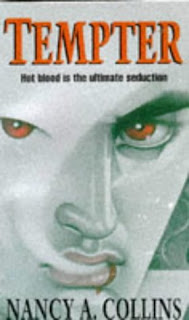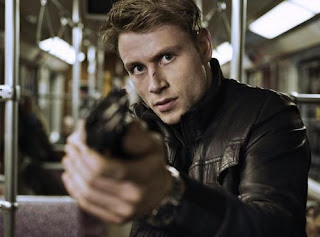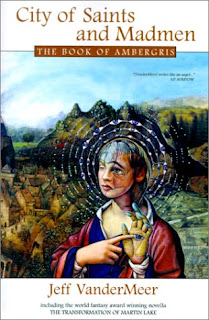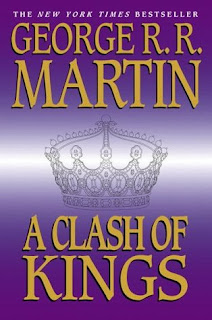ISBN: 978-0-7564-0656-1
Blurb:
Psychic agent Nola O’Grady isn’t sure that returning to San Francisco, and living so close to her very unusual family, is a good idea. Her job, with a psychic agency so obscure that even then CIA doesn’t know it exists, can be perilous, and she’s afraid of the relatives getting involved. Plus the warnings she’s been receiving lately from saints and angels are not making the situation any easier.
Then the Agency saddles her with an Israeli secret agent named Ari Nathan, currently attached to Interpol, and she realizes she has an even bigger problem on her hands, because tact and compromise are not Ari’s strong points.
They are forced to work together, however, to track down a serial killer who seems to have an obsession about werewolves. He sees them everywhere and shoots whenever he thinks he has one in his sights. Ari assumes that the man’s merely psychotic, but in truth, this mystery man is murdering actual werewolves. Nola should know. Her younger brother Pat, a lycanthrope, was the killer’s first victim.
Can Nola’s psychic talents and Ari’s skill with guns keep them alive long enough to unravel the greater mystery that lies behind the killings? And can they save the werewolves and the world while stopping Nola’s family from running headlong into danger?
***
My Thoughts:
If you’ve been reading the blog for a while, you might remember the name Katharine Kerr – I mention her every time I start a new fantasy series. Her Deverry novels are great and complex and I was a bit sad when I finished the fifteenth part and it was all over. I have to admit, I was a wary when I heard that her next project was going to be an urban fantasy. The urban fantasy / paranormal romance market is over-saturated right now and I didn’t want one of my favourite fantasists to join the pack. I had nothing to worry about – yes, this is an urban fantasy, but it’s got enough quirks to set it apart.
What I liked about this book is that it defied my expectations. It’s not about vampires and / or werewolves vying for power against each other and it’s not about pretty-pretty faeries. Instead, it’s about a secret agency trying to keep things in Harmony, monitoring forces of Chaos around the world to try and maintain equilibrium. So Nola sees saints and angels that may or may not just be projections of her own subconscious. And while there are werewolves and a smattering of psychically gifted folks around it’s really about the police case involving several murders rather than Nola hand-holding various boyfriends through their emotional hangups in between orgies.
The line between paranormal romance and urban fantasy has become increasing blurred in the last few years (at least in my head if nowhere else), but this is definitely not a romance novel – yes, there is a romantic relationship, but it’s not the point of the book, the point of the story is to find a killer. So while there is sex it’s all off-screen and tasteful.
There is one thing that bothered me – two ideas were repeated over and over again. First, the fact that Nola is too skinny and doesn't eat enough. I appreciate that Kerr is pointing to the societal pressure about weight, but when Ari (the secret agent man) tells her to eat every other page it got too repetitive and I felt like she was trying to hammer the idea into my head. And while I don't think he should be telling her how much or little she should eat, the point being made here was that Nola either has or is on the borderline of having an eating disorder. She also blacks out a couple of times after doing strenuous psychic stuff, which he quite correctly surmises has to do with her lack of food intake. The second is that Ari Nathan drives like a madman. I understand the fear of other people driving and their insane habits, but they drive a lot in this book and every time they get in a vehicle there is a short passage about how Nola almost dies of fright. Toward the end of the novel, my brain started to substitute “Yes, I know, he drives like a crazy person and she was terrified – I get it.”
The focus on family and mystery – which went hand-in-hand – was what kept me reading. The O’Gradys are eccentric and gifted, but also in the depths of mourning for one of their own. The murder cases interweave with the family story giving the police work a personal feel and drawing attention away from the romance aspect. I appreciated that Nola wasn’t all-powerful (some heroines in these types of books develop new powers every time they are in peril) and that she relied on Ari as her partner – between the two of them they have the skills needed to deal with the assassins, but separately neither of them is able to gain control of the situation. Ari doesn’t have the knowledge of the supernatural to address the situation and Nola doesn’t have the combat / police training. They complement each other nicely. In a way, the ultimate outcome wraps up too neatly, but I still enjoyed it. The subplot with Nola’s little brother Michael and how it eventually connected with the murder plot just added that extra layer of narrative to make the novel as a whole complete.
I’m happy to have found a couple of new urban fantasy series to read (Seanan McGuire’s Toby Daye books are the other) and I’m looking forward to picking up part two of the Nola O’Grady books in August (I think). I want to see where things with Ari and Nola go and I want to learn more about the parallel universes, as well as the struggle between Chaos and Order. I’m hoping that we get to see more of Nola’s family in the second book. We still haven’t met her mother, who sounds like quite the draconic figure from what everyone in this book has said about her. Overall, I'm excited to see Kerr use her skills in weaving a complex narrative in this new setting. As much as I loved the Deverry books, they took up a lot of her writing time over the years and it's refreshing to see her imagination at play in a different world.






























